RBSE Class 9 Maths Important Questions Chapter 12 Heron’s Formula
Rajasthan Board RBSE Class 9 Maths Important Questions Chapter 12 Heron’s Formula Important Questions and Answers.
Rajasthan Board RBSE Solutions for Class 9 Maths in Hindi Medium & English Medium are part of RBSE Solutions for Class 9. Students can also read RBSE Class 9 Maths Important Questions for exam preparation. Students can also go through RBSE Class 9 Maths Notes to understand and remember the concepts easily. Practicing the class 9 math chapter 13 hindi medium textbook questions will help students analyse their level of preparation.
RBSE Class 9 Maths Chapter 12 Important Questions Heron’s Formula
I. Multiple Choice Questions :
Choose the correct answer from the given four options.
Question 1.
If the area of equilateral triangle is 16√3 cm2, then the perimeter of the triangle is :
(a) 48 cm
(b) 24 cm
(c) 12 cm
(d) 36 cm
Answer:
(b) 24 cm

Question 2.
The edge of a triangular board are 6 cm, 8 cm and 10 cm. The cost of painting it at the rate of 9 paise per cm2 is :
(a) ₹ 2.00
(b) ₹ 2.16
(c) ₹ 2.48
(d) ₹ 3.00
Answer:
(b) ₹ 2.16
Question 3.
If the perimeter of a rhombus is 80 cm and one of its diagonals is 24 cm, then the length of the other diagonal is:
(a) 16 cm
(b) 20 cm
(c) 32 cm
(d) 48 cm
Answer:
(c) 32 cm
Question 4.
If the perimeter of an equilateral triangle is 60 m, then the area is :
(a) 10√3 m2
(b) 15√3 m2
(c) 20√3 m2
(d) 100√3m2
Answer:
(d) 100√3m2
Question 5.
An isosceles right triangle has area 8 cm2. The length of its hypotenuse is :
(a) √32 cm
(b) √l6 cm
(c) √48 cm
(d) √24 cm
Answer:
(a) √32 cm

Question 6.
If the sides of a triangle are 56 cm, 65 cm and 52 cm long, then the area of the triangle is :
(a) 1322 cm2
(b) 1311 cm2
(c) 1344 cm2
(d) 1392 cm2
Answer:
(c) 1344 cm2
Question 7.
If the side of a parallelogram are 9 cm and 4 cm, then the ratio of their corresponding altitudes is :
(a) 2 : 3
(b) 3 : 2
(c) 9 : 4
(d) 4 : 9
Answer:
(d) 4 : 9
Question 8.
The sides of a triangle are 35 cm, 54 cm and 61 cm. The length of its longest altitude is:
(a) 16√5 cm
(b) 10√5 cm
(c) 24√5 cm
(d) 28 cm
Answer:
(c) 24√5 cm
Question 9.
The sides of a triangle are in the ratio of 5 : 12 : 13 and its perimeter is 150 cm. The area of the triangle is :
(a) 375 cm2
(b) 750 cm2
(c) 250 cm2
(d) 500 cm2
Answer:
(b) 750 cm2
Question 10.
Each of the equal sides of an isosceles triangle is 13 cm and its base is 24 cm. The area of the triangle is:
(a) 156 cm2
(b) 78 cm2
(c) 60 cm2
(d) 120 cm2
Answer:
(c) 60 cm2
Question 11.
The base of right triangle is 48 cm and its hypotenuse is 50 cm long. The area of the triangle is :
(a) 168 cm2
(b) 252 cm2
(c) 336 cm2
(d) 504 cm2
Answer:
(c) 336 cm2
Question 12.
The base of an isosceles triangle is 8 cm long and each of its equal sides measures 6 cm. The area of the triangle is :
(a) 16√5 cm2
(b) 8√5 cm2
(c) 16√3 cm2
(d) 8√3 cm2
Answer:
(b) 8√5 cm2
Question 13.
Each side of an equilateral triangle is 10 cm long. The height of the triangle is :
(a) 10√3 cm
(b) 5√3 cm
(c) 10√2 cm
(d) 5 cm
Answer:
(b) 5√3 cm

Question 14.
The area of an equilateral triangle is 81 /3 cm2, its height is :
(a) 9√3 cm
(b) 6√3 cm
(c) 18√3 cm
(d) 9 cm
Answer:
(a) 9√3 cm
Question 15.
The lengths of the three sides of a triangular field are 40 m, 24 m and 32 m respectively. The area of the triangle is :
(a) 480 m2
(b) 320 m2
(c) 384 m2
(d) 360 m2
Answer:
(c) 384 m2
II. Fill in the Blanks:
Question 1.
Area of trapezium with parallel sides 'a' and 'b' and the distance between two parallel sides as h = ___________ .
Answer:
\(\frac{1}{2}\)(a + b) × h
Question 2.
Heron's foumula is stated as :
Area of a triangle ABC = ____________
Where s = ____________
a, b, c, = ____________
Answer:
\(\sqrt{s(s-a)(s-b)(s-c)}\), semiperimeter, sides of the triangle,
Question 3.
The semiperimeter of a triangle having the length of its sides as 20 cm, 15 cm and 9 cm is ____________ .
Answer:
22 cm
Question 4.
The perimeter of an equilateral triangle is 60 m. The area is ____________ .
Answer:
100√3 cm2
Question 5.
The sides of a triangle are 56 cm, 60 cm and 52 cm long, then the area of the triangle is ____________.
Answer:
1344 cm2

III. True/False:
State whether the following statements are True or False.
Question 1.
Heron formula for area of triangle is not valid of all triangles.
Answer:
False
Question 2.
If each side of the triangles is tripled, the area will becomes 9 times.
Answer:
True
Question 3.
Base and corresponding altitude of the parallelogram are 8 and 5 cm respectively. Area of parallelogram is 40 cm2.
Answer:
True
Question 4.
If each side of triangle is doubled, the perimeter will become 4 times.
Answer:
False
Question 5.
If p is the perimeter of the triangle of sides a, b, c, the area of triangle is
A = \(\frac{1}{4}\sqrt{p(p-2 a)(p-2 b)(p-2 c)}\).
Answer:
True
Question 6.
When two triangles are congruent, there areas are same.
Answer:
True
Question 7.
Heron belongs to America.
Answer:
False
Question 8.
If the side of the equilateral triangle is a rational number, the area would always be irrational number.
Answer:
True
IV. Match the Columns:
Match the column I with the column II.
|
Column I |
Column II |
|
(1) Perimeter of rectangle of length 24 cm and diagonal 26 cm |
(i) 22 cm |
|
(2) Perimeter of the square of side 10 cm |
(ii) 17 cm |
|
(3) Perimeter of triangle of sides 4, 5, 8 cm |
(iii) 40 cm |
|
(4) Perimeter of parallelogram of two sides 5 and 6 cm respectively |
(iv) 68 cm |
Answer:
|
Column I |
Column II |
|
(1) Perimeter of rectangle of length 24 cm and diagonal 26 cm |
(iv) 68 cm |
|
(2) Perimeter of the square of side 10 cm |
(iii) 40 cm |
|
(3) Perimeter of triangle of sides 4, 5, 8 cm |
(ii) 17 cm |
|
(4) Perimeter of parallelogram of two sides 5 and 6 cm respectively |
((i) 22 cm |

V. Very Short Answer Type Questions:
Question 1.
Find the area of ∆ABC in which AB = BC = 4 cm and ∠B = 90°.
Answer:
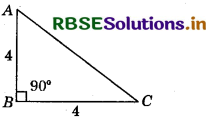
From the figure, ∆ABC is a right-angled triangle.
∴ Area of AABC = \(\frac{1}{2}\) × base × height
= \(\frac{1}{2}\) × (BC) × (AB) = \(\frac{1}{2}\) × 4 × 4 = 8 cm2
∴ ar(∆ABC) = 8 cm2.
Question 2.
Find the side of an isosceles right triangle of hypotenuse 5√2 cm.
Answer:
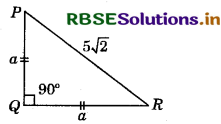
According to the question :
PQ - QR = a (say)
PR = 5√2
∴ By Pythagoras theorem: P2 + B2 = H2
a2 + a2 = (5√2)2
⇒ 2a2 = 50
⇒ a2 = \(\frac{50}{2}\)
⇒ a2 = 25
⇒ a = 5 cm
Hence, equal sides of isosceles triangle are 5 cm each.
Question 3.
The perimeter of an equilateral triangle is 60 m. Find its area.
Answer:
Let side of equilateral be 'a'.
Now, perimeter = 3a
⇒ 3a = 60 m
⇒ a = \(\frac{60}{3}\) = 20 m
Then, area of equilateral triangle = \(\frac{\sqrt{3}}{4}\)(side)2
⇒ area of equilateral triangle = \(\frac{\sqrt{3}}{4}\) × (20)2 = \(\frac{\sqrt{3}}{4}\) × 20 × 20 = 100√3
∴ Area = 100 √3 m2.

Question 4.
Area of an isosceles right triangle is 8 cm2. Find its hypotenuse.
Answer:
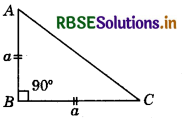
Let ABC be an isosceles right triangle, where
∠B = 90°
Let AB = BC = a
Now, area of ∆ABC = \(\frac{1}{2}\) × base × height
⇒ 8 = \(\frac{1}{2}\) × a × a
⇒ a2 = 16
⇒ a = 4
Now, by Pythagoras theorem
AB2 + BC2 = AC2
⇒ a2 = a2 = AC2
⇒ (4) + (4) = AC2
⇒ 16 + 16 = AC2
⇒ AC2 = 32
⇒ AC = √32
⇒ AC = 4√2 cm
∴ Hypotenuse = 4√2 cm.
VI. Short Answer Type Questions:
Question 1.
If the length of median of an equilateral triangle be x cm, then find its area.
Answer:
Let ABC be an equilateral triangle of side ‘a’ cm. A
Also, we know that in an equilateral triangle, the median and perpendicular coincide with each other.
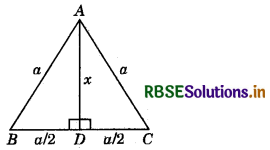
∴ AD ⊥ BC and D is mid-point of BC.
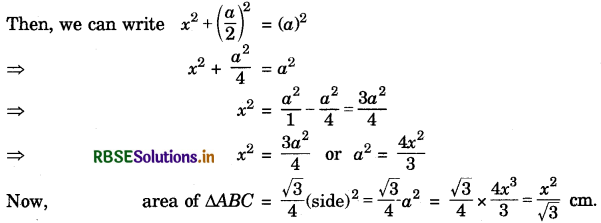
Question 2.
The sides of a triangle are 7 cm, 24 cm and 25 cm. What is its area?
Answer:
Since, sides are given, we use Heron’s formula to find area of triangle.
Let a = 7 cm, b = 24 cm and d = 25 cm
s = \(\frac{a+b+c}{2}\) = \(\frac{7+24+25}{2}=\frac{56}{2}\) = 28
∴ Area = \(\sqrt{s(s-a)(s-b)(s-c)}\)
∴ Area = A = \(\sqrt{28(28-7)(28-24)(28-25)}\)
⇒ A = \(\sqrt{28 \times 21 \times 4 \times 3}\)
⇒ A = \(\sqrt{2 \times 2 \times 7 \times 7 \times 3 \times 2 \times 2 \times 3}\)
⇒ A = 2 × 7 × 3 × 2 = 84
Hence, area of triangle = 84 cm2

Question 3.
The edges of a triangular board are 6 cm, 8 cm and 10 cm. Find the cost of painting it at the rate of 9 paise per cm2.
Answer:
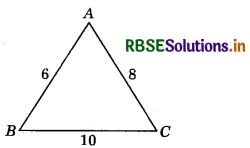
Let a = 10 cm, b = 8 cm and c = 6 cm
Then, s = \(\frac{a+b+c}{2}\) = \(\frac{10+8+6}{2}\) = \(\frac{24}{2}\) = 12
∴ Area = \(\sqrt{12(12-10)(12-8)(12-6)}\)
⇒ Area = \(\sqrt{12 \times 2 \times 4 \times 6}\) = 24
∴ Area = 24 cm2
Now, cost of painting the board at the rate of 9 paise per cm2
= 24 × 0.09 = ₹ 2.16 (∵ 9 paise = ₹ 0.09)
Hence, cost of painting = ₹ 2.16.
Question 4.
In figure, P and Q are two lamp posts. If the area of the ∆PDC is same as that of the rectangle ABCD, find the distance between the two lamp posts.
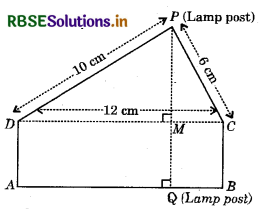
Answer:
In ∆PCD,
a = 12 cm, 6 = 6 cm, c = 10 cm.
s = \(\frac{12+6+10}{2}\) cm = 14 cm.
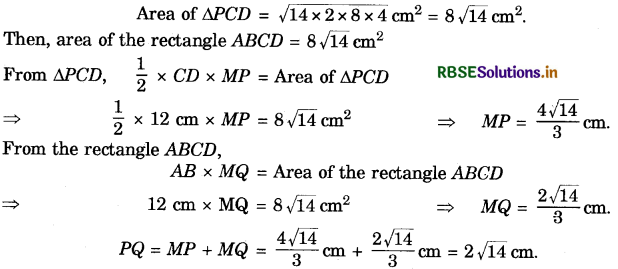

Question 5.
A municipal corporation wall on road side has dimensions as shown in figure. The wall is to be used for advertisements and it yields an earning of ₹ 400 per m2 in a year. Find the total amount of revenue earned in a year.
Answer:
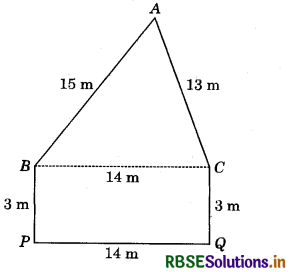
We can find the total area of the wall in two parts. One parts triangular, i.e. ∆ABC at the top and the second part is rectangular, i.e. rectangle PQCB at the bottom.
In triangular part, a = 14 m, b = 13 m, c = 15 m.

The area of rectangle PQCB = 14 × 3 m2 = 42 m2.
Total area of the wall = 84 m2 + 42 m2 = 126 m2
Total amount of revenue earned in a year at the rate of ₹ 400/m2
= ₹ 400 × 126 = ₹ 50,400
Question 6.
Find the area of the pentagon ABCDE shown in figure.
Answer:
In triangle BCD, ∠C = 90°, therefore, by Pythagoras theorem,
BD = \(\sqrt{B C^{2}+C D^{2}}\) = \(\sqrt{4^{2}+3^{2}}\) cm
= \(\sqrt{16+9}\) cm = √25 cm = 5 cm
Again in ∆ABD, ∠ABD = 90°, therefore, by Pythagoras theorem,

Next, we find area ∆ADE using Heron’s formula

Hence, the area of the pentagon ABCDE
= area ∆ABD + area ∆BCD + area ∆ADE
= (30 + 6 + 84) cm2 = 120 cm2

Question 7.
The sides of a triangular park are 8 m, 10 m and 6 m respectively. A small circular area of diameter 2 m is to be left out and the remaining area is to.be used for growing roses. How much area is used for growing roses? (take π = 3.14)
Answer:
Let sides of a triangle be a = 8 m, b = 10 m and c = 6 m
Now, semi-perimeter of a triangle, s = \(\frac{a+b+c}{2}\)
= \(\frac{8+10+6}{2}\) = \(\frac{24}{2}\)= 12 m
Area of a triangle = \(\sqrt{s(s-a)(s-b)(s-c)}\)
= \(\sqrt{12(12-8)(12-10)(12-6)}\)
= \(\sqrt{12 \times 4 \times 2 \times 6}\) = 24 m2
and area of a circle = πr2 = 3.14 × 12
= 3.14 m2
∴ Ares for growing roses = Area of a triangle - area of a circle
= 24 - 3.14 = 20.86 m2
VII. Long Answer Type Questions:
Question 1.
The length of the sides of a triangle are in the ratio 3:4:5 and its perimeter is 144 cm. Find :
(i) the area of the triangle, and
(ii) the height corresponding to the longest side.
Answer:
Given, perimeter = 144 cm
Ratio of sides = 3:4:5
Let the sides be 3x, 4x and 5x
∴ 3x + 4x + 5x = 144
12x = 144
x = 12
1st side, 3x = 3 × 12 = 36 cm
Ilnd side, 4x = 4 × 12 = 48 cm
Illrd side, 5x = 5 × 12 = 60 cm
∴ a = 3x, b = 4x, c = 5x
Now, semi-perimeter of the triangle,
s = \(\frac{a+b+c}{2}\) = \(\frac{36+48+60}{2}\) = \(\frac{144}{2}\) = 72cm
(i) Area of triangle = \(\sqrt{s(s-a)(s-b)(s-c)}\) (By Heron’s formula)
= \(\sqrt{72 \times(72-36)(72-48)(72-60)}\)
= \(\sqrt{72 \times 36 \times 24 \times 12}\)
= \(\sqrt{(36)^{2} \times(24)^{2}}\)
= 36 × 24 = 864 cm2 .
Hence, the area of the given triangle is 864 cm2.
(ii) Let height of a triangle be h cm.
Then, area of triangle = \(\frac{1}{2}\) × base × height
⇒ 864 = \(\frac{1}{2}\) × 60 × h
(Since, longest side of a triangle is 60 cm, so we consider it as base of the triangle.)
⇒ 864 = 30h ⇒ h = 28.8 cm
Hence, the height corresponding to the longest side is 28.8 cm.
Question 2.
A rectangular plot is given for constructing a house having a measurement of 40 m long and 15 m in the front.
According to the laws, a minimum of 3 m wide space should be left in the front and back each and 2 m wide space on each of other sides. Find the largest area, where house can be constructed.
Answer:
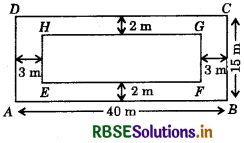
Let ABCD be a rectangular plot having a measurement of 40 m long and 15 m front.
⇒ Length of inner rectangle
= EF = 40 - 3 - 3 = 34 m
and breadth of inner rectangle
= FG = 15 - 2 - 2 = 11 m
Now, when space are left according to the law, then
∴ Area of inner rectangle, EFGH
= EF × FG = 34 × 11 = 374 m2 (∵ Area of a rectangle = length × breadth)
Hence, the largest area, where the house can be constructed, is 374 m2.

Question 3.
A design is made on a rectangular tile of dimensions 50 cm x 70 cm as shown in figure. Find the total area of the design and the remaining area of the tile.
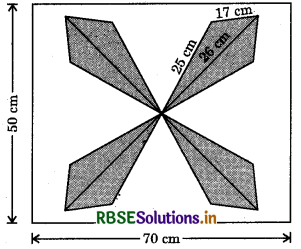
Answer:
We have
Area of the rectangular tile
= (length × breadth) sq. units
= (50 × 70) cm2 = 3500 cm2
For area of each triangle
Let a = 26 cm, b = 17 cm, c = 25 cm
s = \(\frac{a+b+c}{2}\) units
s = \(\frac{26+17+25}{2}\) = \(\frac{68}{2}\) = 34 cm
s - a = 34 - 26 = 8cm
s - b = 34 - 17 = 17 cm
s - c = 34- 25 = 9 cm
Area of each triangle = \(\sqrt{s(s-a)(s-b)(s-c)}\)
= \(\sqrt{34 \times 8 \times 17 \times 9}\)9 = \(\sqrt{2 \times 17 \times 2 \times 2 \times 2 \times 17 \times 9}\)
= 12 × 17 = 204 cm2
∴ Total area of design = 8 × area of one triangle
= (8 × 204) cm2 = 1632 cm2
So,remaining area of the tile = Area of rectangular tile - total area of the design
= 3500 - 1632 = 1868 cm2

- RBSE Solutions for Class 9 Maths Chapter 6 रेखाएँ और कोण Ex 6.3
- RBSE Solutions for Class 9 Maths Chapter 14 सांख्यिकीEx 14.3
- RBSE Solutions for Class 9 Maths Chapter 13 पृष्ठीय क्षेत्रफल एवं आयतन Ex 13.5
- RBSE Solutions for Class 9 Maths Chapter 13 पृष्ठीय क्षेत्रफल एवं आयतन Ex 13.4
- RBSE Solutions for Class 9 Maths Chapter 10 Circles Ex 10.3
- RBSE Solutions for Class 9 Maths Chapter 10 Circles Ex 10.2
- RBSE Solutions for Class 9 Maths Chapter 10 Circles Ex 10.1
- RBSE Solutions for Class 9 Maths Chapter 9 Areas of Parallelograms and Triangles Ex 9.2
- RBSE Solutions for Class 9 Maths Chapter 11 Constructions Ex 11.1
- RBSE Solutions for Class 9 Maths Chapter 9 Areas of Parallelograms and Triangles Ex 9.3
- RBSE Solutions for Class 9 Maths Chapter 11 Constructions Ex 11.2